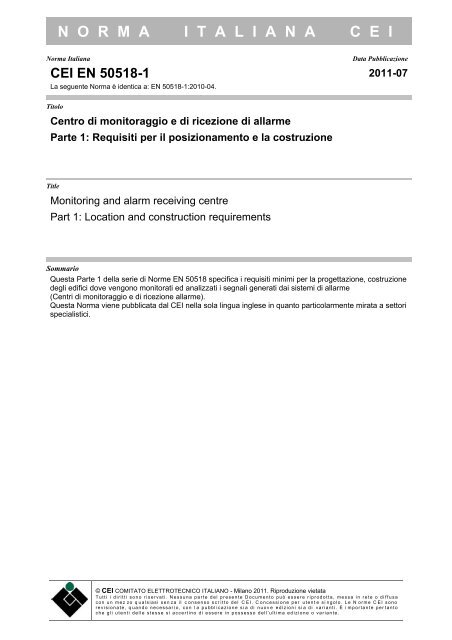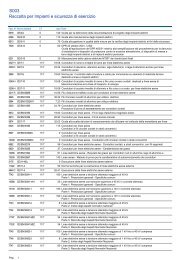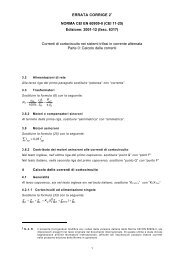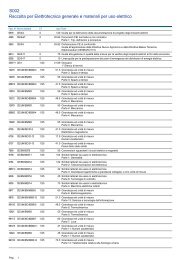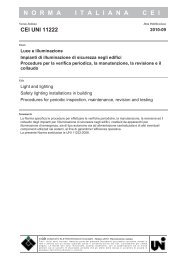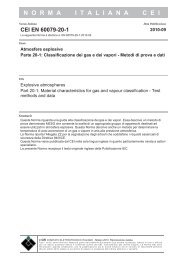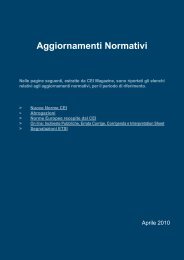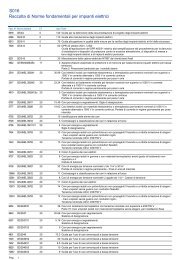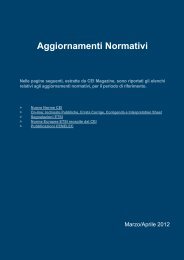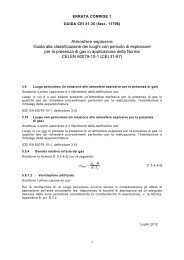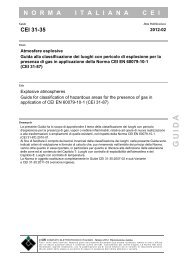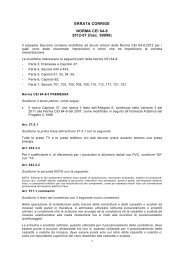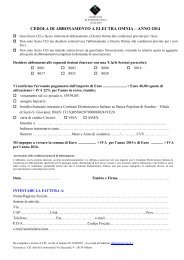EN 50518-1 - CEI
EN 50518-1 - CEI
EN 50518-1 - CEI
You also want an ePaper? Increase the reach of your titles
YUMPU automatically turns print PDFs into web optimized ePapers that Google loves.
N O R M A I T A L I A N A C E I<br />
Norma Italiana<br />
Data Pubblicazione<br />
<strong>CEI</strong> <strong>EN</strong> <strong>50518</strong>-1 2011-07<br />
La seguente Norma è identica a: <strong>EN</strong> <strong>50518</strong>-1:2010-04.<br />
Titolo<br />
Centro di monitoraggio e di ricezione di allarme<br />
Parte 1: Requisiti per il posizionamento e la costruzione<br />
Title<br />
Monitoring and alarm receiving centre<br />
Part 1: Location and construction requirements<br />
Sommario<br />
Questa Parte 1 della serie di Norme <strong>EN</strong> <strong>50518</strong> specifica i requisiti minimi per la progettazione, costruzione<br />
degli edifici dove vengono monitorati ed analizzati i segnali generati dai sistemi di allarme<br />
(Centri di monitoraggio e di ricezione allarme).<br />
Questa Norma viene pubblicata dal <strong>CEI</strong> nella sola lingua inglese in quanto particolarmente mirata a settori<br />
specialistici.<br />
© <strong>CEI</strong> COMITATO ELETTROTECNICO ITALIANO - Milano 2011. Riproduzione vietata<br />
Tutti i diritti sono riservati. Nessuna parte del presente Documento può essere riprodotta, messa in rete o diffusa<br />
con un mez zo qualsiasi sen za il c onsenso scritto del <strong>CEI</strong>. Concessione per utente singolo. Le N orme <strong>CEI</strong> sono<br />
revisionate, quando necessario, con l a pubblicazione sia di nuove edizioni sia di varianti. È i mportante pertanto<br />
che gli utenti delle stesse si accertino di essere in possesso dell’ultima edizione o variante.
DATI ID<strong>EN</strong>TIFICATIVI <strong>CEI</strong><br />
Norma italiana <strong>CEI</strong> <strong>EN</strong> <strong>50518</strong>-1<br />
Classificazione <strong>CEI</strong> 79-67<br />
Edizione<br />
COLLEGAM<strong>EN</strong>TI/RELAZIONI TRA DOCUM<strong>EN</strong>TI<br />
Nazionali<br />
Europei (IDT) <strong>EN</strong> <strong>50518</strong>-1:2010-04;<br />
Internazionali<br />
Legislativi<br />
Legenda<br />
(IDT) - La Norma in oggetto è identica alle Norme indicate dopo il riferimento (IDT)<br />
INFORMAZIONI EDITORIALI<br />
Pubblicazione Norma Tecnica<br />
Stato Edizione In vigore<br />
Data validità 01-08-2011<br />
Ambito validità<br />
Fascicolo<br />
Ed. Prec. Fasc.<br />
Comitato Tecnico<br />
Internazionale<br />
11380 E<br />
Nessuna<br />
CT 79-Sistemi di rilevamento e segnalazione per incendio, intrusione, furto, sabotaggio e<br />
aggressione<br />
Approvata da Presidente del <strong>CEI</strong> In data 14-06-2011<br />
C<strong>EN</strong>ELEC In data 01-04-2010<br />
Sottoposta a Inchiesta pubblica come Documento originale Chiusura in data 09-10-2009<br />
ICS 13.320;<br />
2
EUROPEAN STANDARD <strong>EN</strong> <strong>50518</strong>-1<br />
NORME EUROPÉ<strong>EN</strong>NE<br />
EUROPÄISCHE NORM April 2010<br />
ICS 13.320<br />
Recepita come <strong>CEI</strong> <strong>EN</strong> <strong>50518</strong>-1:2011-07<br />
English version<br />
Monitoring and alarm receiving centre -<br />
Part 1: Location and construction requirements<br />
Centre de contrôle et de réception<br />
d’alarme -<br />
Partie 1: Exigences pour l’emplacement<br />
et la construction<br />
Notruf- und Serviceleitstellen (NSL) -<br />
Teil 1: Örtliche und bauliche<br />
Anforderungen<br />
This European Standard was approved by C<strong>EN</strong>ELEC on 2010-04-01. C<strong>EN</strong>ELEC members are bound to comply<br />
with the C<strong>EN</strong>/C<strong>EN</strong>ELEC Internal Regulations which stipulate the conditions for giving this European Standard<br />
the status of a national standard without any alteration.<br />
Up-to-date li sts a nd bib liographical re ferences con cerning su ch national stan dards may be ob tained on<br />
application to the Central Secretariat or to any C<strong>EN</strong>ELEC member.<br />
This Eu ropean Stand ard exists in th ree o fficial versions (Engl ish, F rench, Ge rman). A ve rsion in any other<br />
language made by translation under the responsibility of a C<strong>EN</strong>ELEC member into its own language and notified<br />
to the Central Secretariat has the same status as the official versions.<br />
C<strong>EN</strong>ELEC members are the national electrotechnical committees of Austria, Belgium, Bulgaria, Croatia, Cyprus,<br />
the Czech Repu blic, Denmark, Eston ia, F inland, F rance, Ge rmany, Greece, H ungary, Icel and, Ireland, Italy,<br />
Latvia, Lithuania, Luxembourg, Malta, the Netherlands, Norway, Poland, Portugal, Romania, Slovakia, Slovenia,<br />
Spain, Sweden, Switzerland and the United Kingdom.<br />
C<strong>EN</strong>ELEC<br />
European Committee for Electrotechnical Standardization<br />
Comité Européen de Normalisation Electrotechnique<br />
Europäisches Komitee für Elektrotechnische Normung<br />
Management Centre: Avenue Marnix 17, B - 1000 Brussels<br />
© 2010 C<strong>EN</strong>ELEC - All rights of exploitation in any form and by any means reserved worldwide for C<strong>EN</strong>ELEC members.<br />
Ref. No. <strong>EN</strong> <strong>50518</strong>-1:2010 E
Recepita come <strong>CEI</strong> <strong>EN</strong> <strong>50518</strong>-1:2011-07<br />
<strong>EN</strong> <strong>50518</strong>-1:2010 – 2 –<br />
Foreword<br />
This European Standard was p repared by the Tech nical Committee C<strong>EN</strong>ELEC TC 79, Alarm systems. It<br />
was submitted to the formal vote and approved by C<strong>EN</strong>ELEC on 2010-04-01.<br />
Attention is drawn to the possibility that some of the elements of this docum ent may be the subject of<br />
patent right s. C<strong>EN</strong> and C<strong>EN</strong>ELEC sha ll not be held respon sible for identifying any or all su ch pate nt<br />
rights.<br />
The following dates were fixed:<br />
– latest date by which the <strong>EN</strong> has to be implemented<br />
at national level by publication of an identical<br />
national standard or by endorsement<br />
– latest date by which the national standards conflicting<br />
with the <strong>EN</strong> have to be withdrawn<br />
(dop) 2011-04-01<br />
(dow) 2013-04-01<br />
<strong>EN</strong> <strong>50518</strong> wil l con sist of the followin g parts, un der the gene ric t itle “ Monitoring and alarm receiving<br />
centre”:<br />
- Part 1: Location and construction requirements;<br />
- Part 2 1) : Tech nical requirements;<br />
- Part 3 1): Procedures and requirements for operation.<br />
__________<br />
———————<br />
1) At draft stage.
Recepita come <strong>CEI</strong> <strong>EN</strong> <strong>50518</strong>-1:2011-07<br />
– 3 – <strong>EN</strong> <strong>50518</strong>-1:2010<br />
Contents<br />
Introduction ............................................................................................................................................ 4<br />
1 Scope ............................................................................................................................................... 6<br />
2 Normative references ..................................................................................................................... 6<br />
3 Terms, definitions and abbreviations .......................................................................................... 7<br />
3.1 Terms and definitions ............................................................................................................. 7<br />
3.2 Abbreviations ......................................................................................................................... 9<br />
4 Site selection .................................................................................................................................. 9<br />
4.1 Risk assessment .................................................................................................................... 9<br />
4.2 Site location ............................................................................................................................ 9<br />
4.3 Site accessibility ..................................................................................................................... 9<br />
5 Construction .................................................................................................................................. 10<br />
5.1 ARC structure ....................................................................................................................... 10<br />
5.2 Facilities ............................................................................................................................... 10<br />
5.3 Openings .............................................................................................................................. 11<br />
5.4 Entrance lobby ...................................................................................................................... 11<br />
5.5 Lock mechanisms ................................................................................................................. 11<br />
5.6 Emergency exit ..................................................................................................................... 12<br />
5.7 Glazed areas ........................................................................................................................ 12<br />
5.8 Ventilation ............................................................................................................................ 12<br />
5.9 Service inlets and outlets ...................................................................................................... 12<br />
5.10 Transfer hatch / chute ........................................................................................................... 12<br />
6 Alarm systems of ARC ................................................................................................................. 13<br />
6.1 External attack ..................................................................................................................... 13<br />
6.2 Fire ........................................................................................................................................ 13<br />
6.3 Entry/exit .............................................................................................................................. 13<br />
6.4 Gas ....................................................................................................................................... 13<br />
6.5 Communications .................................................................................................................. 14<br />
6.6 Hold-up ................................................................................................................................. 14<br />
6.7 Personnel safety monitoring ................................................................................................. 14<br />
6.8 Signals from the protection systems .................................................................................... 14<br />
6.9 Closed-circuit television surveillance .................................................................................... 14<br />
7 Electrical power supplies ............................................................................................................. 14<br />
7.1 Mains supply ......................................................................................................................... 14<br />
7.2 Standby power supplies ....................................................................................................... 15<br />
Annex A (informative) Lock code requirements ................................................................................ 16<br />
A.1 Electromechanical locks ....................................................................................................... 16<br />
A.2 Mechanical locks (<strong>EN</strong> 12209) ............................................................................................... 17<br />
Annex B (informative) Typical ARC layout ......................................................................................... 18<br />
Bibliography ......................................................................................................................................... 19<br />
Figures<br />
Figure 1 – Chain diagram of the total alarm process ............................................................................... 5<br />
Figure B.1 – Typical ARC layout ............................................................................................................ 18<br />
Tables<br />
Table 1 – Minimum resistance against physical attack for ARC ............................................................ 10<br />
Table 2 – Resistance class ..................................................................................................................... 11<br />
Table 3 – Physical attack and bullet attack ............................................................................................ 12<br />
Table 4 – Performance parameters of the dual path system ................................................................. 14
Recepita come <strong>CEI</strong> <strong>EN</strong> <strong>50518</strong>-1:2011-07<br />
<strong>EN</strong> <strong>50518</strong>-1:2010 – 4 –<br />
Introduction<br />
This European Standard applies to Monitoring and Alarm Receiving Centres (MARC) that monitor and/or<br />
receive and/or process signals that require an emergency response.<br />
In all existing <strong>EN</strong> 50131 series accomplished under CLC/TC 79, Alarm systems, the abbreviation ARC is<br />
used. To avo id confusion and to a chieve consistency in terminol ogy the ab breviation ARC will be used<br />
throughout this European Standard, where MARC is equivalent for ARC.<br />
The fun ction of receivin g, pro cessing and initia ting re sponse action s by (huma n) int ervention for<br />
information provided by al arm systems is not limit ed to only those signals as g enerated by Intrude r and<br />
Hold-up Al arm Systems (I&HAS). The whol e serie s of sta ndards u nder CL C/TC 79, Alarm sy stems,<br />
encompasses CCTV surveillance systems (<strong>EN</strong> 50132), social alarm systems (<strong>EN</strong> 50134), access control<br />
systems (E N 50133) an d audio and video do or entry systems. All menti oned system s can sen d<br />
information, inclu ding ala rms, to one or more remo te location s for furthe r proce ssing, evaluation an d<br />
(human) intervention.<br />
All alarm info rmation g enerated by oth er sy stems e .g. fire detect ion and fire alarm system s, (vehicle)<br />
tracking and tracing systems, guarding or telecommunication network supervision is regularly transmitted<br />
to one or more remote locations for further processing, evaluation and (human) intervention.<br />
In all above circumstances external and internal criminal action, emergency situations and/or calamities<br />
can jeopardize the safety and security of human beings and or properties. The central locations where the<br />
receiving, proce ssing an d initiation of (huma n) intervention take pla ce should co mply with the<br />
requirements of this European Standard.
Recepita come <strong>CEI</strong> <strong>EN</strong> <strong>50518</strong>-1:2011-07<br />
– 5 – <strong>EN</strong> <strong>50518</strong>-1:2010<br />
Premises or<br />
Objects (risks)<br />
<strong>EN</strong> 50131-1<br />
<strong>EN</strong> 50132<br />
<strong>EN</strong> 50133<br />
<strong>EN</strong> 50134-1<br />
Detection of an<br />
unwanted<br />
situation<br />
<strong>EN</strong> 50131-2-x<br />
series<br />
Technical<br />
Human Intervention<br />
C<strong>EN</strong>/TF 167<br />
Signals are being<br />
processed and<br />
evaluated<br />
<strong>EN</strong> 50131-3<br />
Law Enforced<br />
Agency (LEA)<br />
Key holder<br />
Private<br />
guard<br />
Non human<br />
intervention<br />
Notification<br />
Alarm Receiving Centre<br />
<strong>EN</strong> 50136 series<br />
Signals are processed<br />
and evaluated.<br />
local<br />
<strong>EN</strong> 50131-4<br />
Figure 1 – Chain diagram of the total alarm process<br />
It is noted that this European Standard cannot supersede any legislative requirements deemed necessary<br />
by a National Government to control the security sector on a national basis. This European Standard<br />
cannot interfere with items that are regulated by (inter)national regulations concerning external services<br />
(e.g. water, waste water, fuel supplies for gas and/or oil and mains power supplies).
Recepita come <strong>CEI</strong> <strong>EN</strong> <strong>50518</strong>-1:2011-07<br />
<strong>EN</strong> <strong>50518</strong>-1:2010 – 6 –<br />
1 Scope<br />
This Part 1 of <strong>EN</strong> <strong>50518</strong> specifies the minimum requirements for the design, construction, and functioning<br />
equipment for premises where the monitoring, receiving and processing of (a larm) signals generated by<br />
alarm systems takes place as a n i ntegrated pa rt of the total safety an d se curity process. Th e<br />
requirements apply for applications in a remote configuration where multiple systems report to a single or<br />
multiple Alarm Receiving Centre(s) (ARC) as well as to a single site facility aimed for the monitoring and<br />
processing o f alarm s ge nerated by on e or m ore alarm systems installe d wit hin the p erimeter of that<br />
particular site.<br />
2 Normative references<br />
The follo wing referen ced documents a re in dispensable for th e a pplication of this do cument. For date d<br />
references, o nly the editio n cite d ap plies. Fo r undated refe rences, the l atest edition of th e refe renced<br />
document (including any amendments) applies.<br />
<strong>EN</strong> 54 series Fire detection and fire alarm systems<br />
<strong>EN</strong> 179 2008 Building hardware – Emergency exit devices operated by a lever<br />
handle or push pad, for use on escape routes – Requirements and test<br />
methods<br />
<strong>EN</strong> 356 1999 Glass in building – Security glazing – Testing and classification of<br />
resistance against manual attack<br />
<strong>EN</strong> 1063 1999 Glass in building – Security glazing – Testing and classification of<br />
resistance against bullet attack<br />
<strong>EN</strong> 1303 2005 Building hardware – Cylinders for locks – Requirements and test<br />
methods<br />
<strong>EN</strong> 1522 1998 Windows, doors, shutters and blinds – Bullet resistance –<br />
Requirements and classification<br />
<strong>EN</strong> 1627 2) Pedestrian doorsets, windows, curtain walling, grilles and shutters –<br />
Burglar resistance – Requirements and classification<br />
<strong>EN</strong> 1906 2002 Building hardware – Lever handles and knob furniture –<br />
Requirements and test methods<br />
<strong>EN</strong> 12209 2003 Building hardware – Locks and latches – Mechanically operated locks,<br />
latches and locking plates – Requirements and test methods<br />
<strong>EN</strong> 13501-2 2007 Fire classification of construction products and building elements –<br />
Part 2: Classification using data from fire resistance tests, excluding<br />
ventilation services<br />
<strong>EN</strong> 13779 2007 Ventilation for non-residential buildings – Performance requirements<br />
for ventilation and room-conditioning systems<br />
<strong>EN</strong> 14846 2008 Building hardware – Locks and latches – Electromechanically operated<br />
locks and striking plates – Requirements and test methods<br />
<strong>EN</strong> 50131-1 2006 Alarm systems – Intrusion and hold-up systems –<br />
Part 1: System requirements<br />
<strong>EN</strong> 50131-4 2009 Alarm systems – Intrusion and hold-up systems –<br />
Part 4: Warning devices<br />
———————<br />
2) At draft stage.
Recepita come <strong>CEI</strong> <strong>EN</strong> <strong>50518</strong>-1:2011-07<br />
– 7 – <strong>EN</strong> <strong>50518</strong>-1:2010<br />
CLC/TS 50131-7 2008 Alarm systems – Intrusion and hold-up systems –<br />
Part 7: Application guidelines<br />
<strong>EN</strong> 50132-7 1996 Alarm systems – CCTV surveillance systems for use in security<br />
applications – Part 7: Application guidelines<br />
<strong>EN</strong> 50136-1 3) Alarm systems – Alarm transmission systems –<br />
Part 1: General requirements for alarm transmission systems<br />
<strong>EN</strong> 50272-2 2001 Safety requirements for secondary batteries and battery installations –<br />
Part 2: Stationary batteries<br />
<strong>EN</strong> 62040-1 2008 Uninterruptible power systems (UPS) –<br />
Part 1: General and safety requirements for UPS (IEC 62040-1)<br />
<strong>EN</strong> 62305 series Protection against lightning (IEC 62305 series)


